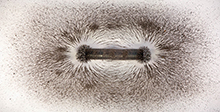
A visualization of otherwise invisible magnetic field lines associated with a bar magnet hints of the far weaker biomagnetic fields from hearts and brains that the AMBIIENT program aims to measure with unprecedented ease. Image courtesy of DARPA.
Each heartbeat or burst of brain activity relies on tiny electrophysiological currents that generate minuscule ripples in the surrounding magnetic field. By boosting the ability to detect faint magnetic fields, a new Defense Advanced Research Projects Agency (DARPA) program-Atomic Magnetometer for Biological Imaging In Earth’s Native Terrain (AMBIIENT)-could open pathways to sensors with uses ranging from biological imaging to magnetically based navigation. Possibilities include, for example, sensor systems for detecting spinal signals, diagnosing concussions, and brain-machine interfaces for such uses as controlling prosthetic limbs and external machines via the subtle magnetic signals associated with thought.
The Earth’s powerful magnetic field has been preventing biomagnetic field sensing from extending beyond its current limitations. Additionally, today’s leading-edge magnetic field sensors provide a limited dynamic range, which means they are unable to respond reliably in the presence of magnetic field strengths that span many orders of magnitude, as is the case when biological magnetic fields superimpose upon Earth’s own magnetism. Without intense shielding, those magnetic whispers from biology would be lost amidst the Earth’s magnetism, even with the best available sensors in play.
“Traditionally, measuring small magnetic signals in ambient environments has relied on pairs of high-performance sensors separated by a baseline distance and then measuring the small field-strength differences between the two sensors,” said Robert Lutwak, PhD, AMBIIENT’s program manager in DARPA’s Microsystems Technology Office. “This gradiometric technique has worked well for applications in geophysical surveying and unexploded ordnance detection but due to the combination of the sensors’ limited dynamic range and the natural spatial variation of the background signals, this approach falls several orders of magnitude short of being able to detect biological magnetic signals.”
The AMBIIENT program is challenging the research community to devise new types of high-sensitivity magnetic gradiometers, without shielding and with whatever the ambient magnetic field environment might be.




